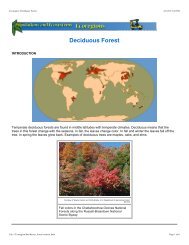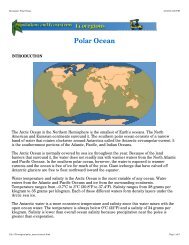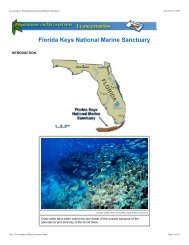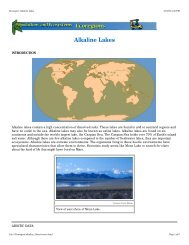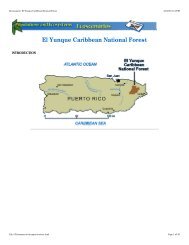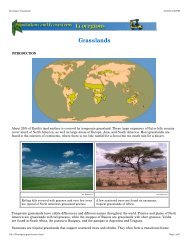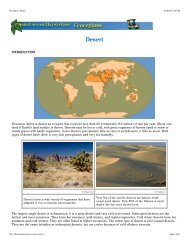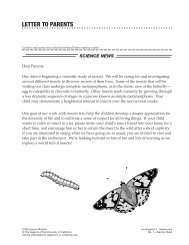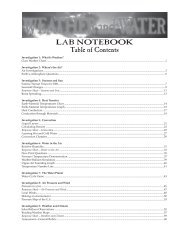Ecoscenarios Combined - FOSSweb
Ecoscenarios Combined - FOSSweb
Ecoscenarios Combined - FOSSweb
Create successful ePaper yourself
Turn your PDF publications into a flip-book with our unique Google optimized e-Paper software.
Ecoscenario: Saguaro National Park<br />
4/16/03 3:23 PM<br />
include snowmobiles. On the water, jet skis are considered ORVs.<br />
Off-road driving has become a favorite past time for people living near the desert. In 1997 there were 48,900 ORVs<br />
registered in Arizona. People like to drive ORVs in the desert because it is dry and the terrain is fun.<br />
Art Explosion<br />
Some national parks and wilderness areas have<br />
roads that are specifically designated for four-wheel<br />
drive and off-road use.<br />
Courtesy of Bureau of Land Management<br />
Off-road vehicles travel along a well-worn dirt road.<br />
The desert floor may look flat, but it actually has parallel ridges. Rainwater from seasonal storms moves sand as it<br />
drains off the desert floor. This creates ridges. Driving across the desert floor can feel like you are driving across a<br />
giant rippled potato chip. Spaces between cacti and other plants are often not big enough for ORVs to pass easily.<br />
Some people enjoy the challenge of figuring out how to drive across the ridged ground through all the plants. Other<br />
people enjoy racing on hillsides or dunes. Some people are out to explore, and like to drive up washes. Washes are<br />
good places to look for animal life, because sometimes there are ponds of water left from rains.<br />
The continued ORV use has long-term effects on the desert. Vegetation is torn up, desert pavement is destroyed,<br />
and soil is compacted. Rainwater cannot be absorbed in the compacted soil, and with no vegetation to hold it, water<br />
quickly flows away. This increases erosion and sediment flowing into rivers.<br />
Animals that burrow cannot dig into compacted soil. Animals, such as desert tortoises and horned lizards, are<br />
camouflaged by sandy soil. They are often overlooked or mistaken for rocks. Desert tortoises move too slowly to<br />
escape speeding vehicles, and many are killed.<br />
What has happened<br />
ORV advocates and conservationists came to a compromise over off-roading in some popular desert areas. At<br />
Imperial Dunes, near San Diego, California, an off-roading organization was able to keep the dunes from being<br />
included in the Desert Protection Act. This act closed 2.8 million hectares (7 million acres) to off-roading in<br />
southern California.<br />
The amount of land available to off-roading may be changing. In 2000, just before leaving office, President Clinton<br />
signed the Roadless Initiative, declaring 24 million hectares (60 million acres) as roadless areas. This restricts<br />
access to about 31% of the wilderness areas controlled by the U.S. Forest Service for ORVs. New roads cannot be<br />
built in these wilderness areas. The Roadless Initiative changes the mission of the U.S. Forest Service. While it<br />
used to be involved in multiple uses of the forest lands, like logging, grazing, and recreation, the Forest Service will<br />
now focus on preserving wilderness areas. Implementation of the Roadless Initiative is still being reviewed by<br />
President Bush's administration in 2003.<br />
THE DEBATE<br />
file:///Ecoscenario/saguaro/content.html<br />
Page 9 of 12



